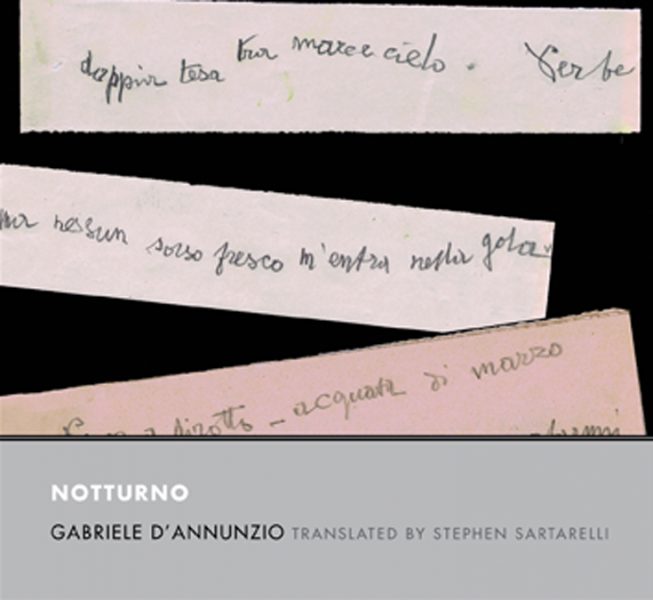The All-Being Eye: Gabriele D’Annunzio’s Somatic Visions of Wartime Italy
 In January 1916, Gabriele D’Annunzio was flying a dangerous propaganda mission as a fighter pilot in the First World War when his plane was shot down by enemy fire. Suffering extreme pain from a detached retina in his right eye, the eminent Italian poet and political activist was forced to remain immobile for months with both eyes bandaged. In order to continue writing in such a physically restrictive condition, D’Annunzio began composing on thin strips of paper, each containing a single line of prose so that his words wouldn’t overlap. These strips, which numbered in the thousands, were eventually collated and published as the autobiographical prose-poem, Notturno, in 1921.
In January 1916, Gabriele D’Annunzio was flying a dangerous propaganda mission as a fighter pilot in the First World War when his plane was shot down by enemy fire. Suffering extreme pain from a detached retina in his right eye, the eminent Italian poet and political activist was forced to remain immobile for months with both eyes bandaged. In order to continue writing in such a physically restrictive condition, D’Annunzio began composing on thin strips of paper, each containing a single line of prose so that his words wouldn’t overlap. These strips, which numbered in the thousands, were eventually collated and published as the autobiographical prose-poem, Notturno, in 1921.
It is tempting to envision Notturno as D’Annunzio’s phoenix, rising from the ashes of his wartime trauma and subsequent convalescence. The speaker claims to discover a new creative organ in place of the literal one he has lost. “Out of my torpor, my sweat, my suffering, my tedium, my despair,” he writes, “a boon beyond expression is born. The right eye: Isn’t that what we call one’s most precious possession? You have given your right eye to the one you love: your seeing eye, your poet’s light.”
The narrative that unfolds itself, image by image, from this (un)seeing eye is also reminiscent of the phoenix’s cycling between life and death. In one moment we are reliving the freedom and sensual joys of the poet’s youth in the cities and countryside of Tuscany; the next we are plunged into the burning heat and screaming anguish of metal, blood, and fire – D’Annunzio’s memories merged into a single throbbing sensation by the trauma of combat.
And yet, this fiery furnace does not give way to sweet renewal, at least not for the majority of the text. Instead it is followed by the third stage of D’Annunzio’s cyclical rebirth – the agony of a claustrophobic death in life:
Then only the four posts of my bed exist. I sense them in the darkness like the four stakes of a tent in the desert.
Then only my bones exist, only my skeleton wrapped in flesh. And inside the skeleton, a sort of sudden coagulation of life.
Life clots, curdles like blood no longer flowing. It is a terrible weight.
This sensation is a product of D’Annunzio’s invalid condition, but only on the surface. It more poignantly reflects the self-altering experience of losing his fellow soldiers on the battlefield, particularly his flying partner. “There is no nobler bond in the world today,” he mourns, “than this tacit pact that turns two lives and two wings into a single speed, a single prowess, a single death.” For the speaker, the boundaries between a physical and psychological bond with his brethren are dissolved by the fury of combat. Though he has survived them, he continues to carry them as if they were corporeal, more akin to a collection of dead limbs than ghosts.
Stephen Sartarelli’s translation – the first complete edition of Notturno in English – captures D’Annunzio’s beautiful and grotesque rendering of this transformation. It also masters the subtle conflict of emotions experienced by the speaker regarding the “creature” he has become. While his new orientation gives him a certain solace, (“Though I suffer, and though he suffers no more, the flesh dissolves for both of us, as our spirits rejoin”) more often it makes memory unbearable as he cannot control what he relives:
My heart beats in my throat, throbs in my palate, knocks at my teeth.
Reality bursts through my dream; and my dream cuts through reality.
At the poem’s close, D’Annunzio experiences some measure of genuine renewal as his body and psyche heal. Yet the flavor and orientation of the author’s prose maintains its memorable corporality. As readers, we are left with a clear understanding of (and appetite for) the author’s self-proclaimed approach to experience:
Life is not an abstraction of aspects and events but a kind of diffuse sensuality,
a consciousness available to all the sense,
a substance to be smelled, touched, eaten.




